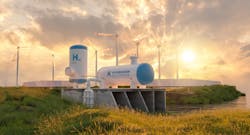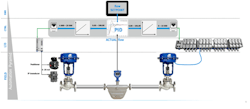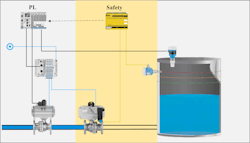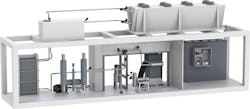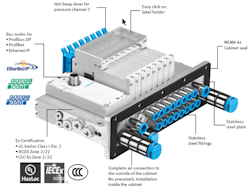Key highlights
- The transition to hydrogen as a clean energy source creates opportunities for controls engineers to apply their expertise in process automation, safety systems and distributed control strategies.
- Since hydrogen production is currently more expensive than traditional fuels, controls engineers play a key role in lowering costs by adopting automation solutions like valve manifolds, proportional control and modular skids.
- Moving away from traditional DCS setups with numerous I/O cards and wiring toward simplified manifold-based systems reduces panel footprint, wiring complexity and maintenance.
Hydrogen has many advantages as a future source of low-carbon-emitting energy. It’s the most abundant element in the universe, which eliminates scarcity and supply concerns common to other energy sources. It has more energy by weight than gasoline, and expends it more cleanly. The only byproducts of a hydrogen fuel cell producing electricity are water vapor and heat, making it a zero-emissions source.
The downside of hydrogen is it’s more expensive to produce than other forms of energy. For example, it’s two to three times more costly per unit of energy than gasoline. Strategies are needed to reduce hydrogen production costs, and process automation strategies can accomplish them.
Where hydrogen is applied
Hydrogen will be a major contributor to reducing energy costs and CO2 emissions at large-scale facilities with heavy energy requirements, such as steel, cement, chemical and fertilizer plants. Hydrogen produced by electrolysis—breaking up water molecules into component hydrogen and oxygen atoms—will be vital to meeting the energy needs of data centers and establishing local and decentralized energy grids.
Hydrogen can also efficiently fuel over-the-road transportation and power maritime shipping, as well as generate electricity to power electric vehicles (EV). Many municipalities already operate hydrogen-fueled buses. Electrolyzing hydrogen can also be an excellent way to storage energy generated by wind and solar facilities.
DCS for traditional hydrogen
Hydrogen used in chemical processing, rather than energy generation, has a long history in industries, such as ammonia production for fertilizer and petroleum refining. Distributed control systems (DCS) are the primary process controls for producing hydrogen in these applications, so they may also be used for energy generation.
In a typical DCS, large control panels with PLCs and many I/O cards are located outside hazardous, hydrogen-production zones. Each I/O card is connected via individual wires to a field device or pneumatic solenoid valve actuated by compressed air. For control valves requiring a positioner, there must be two I/O cards running wires to each valve, including one wire for the setpoint and another wire for feedback. More individually attached wires and I/O cards mean more costs for materials, installation, software licenses and maintenance, as well as larger footprints in the control panel.
To minimize materials, installation and maintenance costs, Festo recommends eliminating the valve positioner in favor of a valve manifold connected via pneumatic tubing to a proportional control valve. Our application engineers estimate that proportional control offers a 50% cost advantage over positioners because I/O cards, wires and other hardware are eliminated, making control panels smaller and less complex. Proportional control’s simpler maintenance and troubleshooting would also increase uptime (Figure 1).
In addition, proportional control is ideal for safety instrumented systems (SIS). Users can create a simple, cost-effective safety circuit up to SIL 3 with a host PLC, safety PLC, manifold, proportional control valves, and a solenoid valve to evacuate the air during a safety shutdown (Figure 2).
Everyone who’s designed an SIS knows safety circuits are challenging. While positioners and traditional architectures still work, more cost-effective process automation alternatives are available.
Get your subscription to Control's tri-weekly newsletter.
Modular hydrogen production adds flexibility
Because it’s not feasible to build a DCS at every point of a hydrogen-generation process, producers are developing modular generation skids for steam methane reforming or electrolysis. Skids are designed using a cookie-cutter approach, with standardized components in each manufacturer’s skid, including controls, valves and field devices (Figure 3).
Modularity reduces costs and increases flexibility because the number of skids can be scaled to match each site’s required output, and redeployed as needed to extend their useful life. Skids can also be remotely monitored and cost maintained by technicians located anywhere, which also minimizes costs.
Similar to a DCS, the valve manifold/proportional valve strategy eliminates wires to each valve assembly for easier maintenance. Less cabling also shrinks control panels, which is ideal for skids. This network architecture includes emergency shutdown by zones and centralized air generation.
Building a skid with a Class 1 Div. 2 control panel means it can serve in hazardous areas, which further reduces its footprint. To assist these efforts, Festo recently developed its VTUG-EX that’s reported to be the world’s first valve manifold with fieldbus connectivity for Class 1 Div. 2 applications. For DCSs, a Class 1 Div. 2 rating lets designers, developers and users move a skid’s control panels closer to their production processes and cut more costs (Figure 4).
Skid control panels also benefit from modularity by using cookie-cutter designs that are pretested before installation and shorten time to market. For example, Festo’s engineers determine that standardized control panels with valve manifolds for proportion control can reduce expenses by more than 50% compared to typical control panels. These efficiencies and savings help reduce the cost of hydrogen generation, enabling users to move toward an abundant, cost-effective, low-carbon energy future.
Energy source key to hydrogen production
To achieve hydrogen’s full potential as a clean energy source, the electricity used to produce it must also be low-carbon emitting. Conversely, hydrogen’s cleanliness is defeated if it’s made with power that’s high CO2 emitting.
“Blue” and “green” are the two names for preferred, low-emissions methods of producing hydrogen. Blue refers to hydrogen produced from natural gas to run a process like steam reforming, while adding carbon capture and storage (CCS) technology, which collects the CO2 produced during production and stores it underground.
Green hydrogen uses a clean energy source like wind or solar power to power electrolysis. Using valve manifolds and proportion control for process automation can enable blue and green hydrogen’s lower-cost and clean-energy goals.
Functional safety in automation
Functional safety is the ability of a system to reach and maintain a predictable, safe state, even if faults or malfunctions occur. The designer of a functionally safe automation system identifies potential hazards, and implements suitable measures to minimize risks and avoid accidents.
The safety integrity level (SIL) is a key measure that indicates a system’s degree of functional safety. Equipment and systems are designated SIL1 (lowest risk) to SIL4 (highest risk) depending on their hazard potential.
To improve functional safety in automation technology, a safety circuit, or safety instrumented system (SIS), usually includes:
- Sensors, such as pressure, temperature, fill level gauge
- Evaluation and output unit, such as a safety PLC
- Automated process valve, including a solenoid valve, actuator and process valve
Actuator units for safety applications
Complete actuator units, whether single or double-acting, are used for functional safety. In a complete actuator unit, a certified individual valve is mounted on the actuator, and controlled directly by the safety PLC. Usually, there are separate actuated process valves installed in these systems, where one process valve operates in basic operation mode, while the other serves as an emergency shutdown.
Control panels for safety applications
Control panels are typically customized to users’ specifications and requirements. They protect components from environmental factors, fluids and foreign matter. In functionally safe systems, a valve manifold for basic operation mode is paired with a single solenoid valve for safety shutdown. A certified individual valve is controlled directly by the safety PLC and switches off safely.
Certified valves can be used up to SIL3 level. In addition, control panels in hazardous locations, such as those found in hydrogen production, are certified for safe operation in Class 1, Division 2 environments, where flammable gases, vapors or liquids are handled, processed or used. This is where ignitable concentrations aren’t usually present under normal operating conditions, but could occur under abnormal conditions, such as leaks or equipment failures.
About the Author

Leaders relevant to this article:
